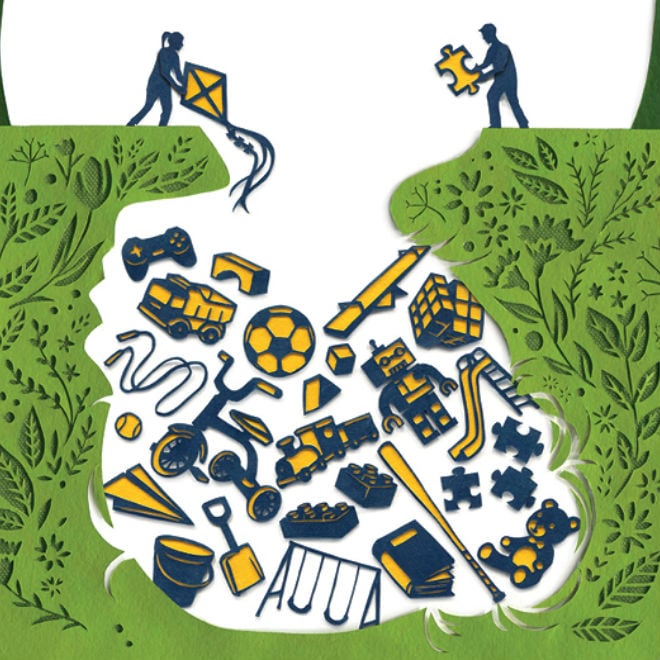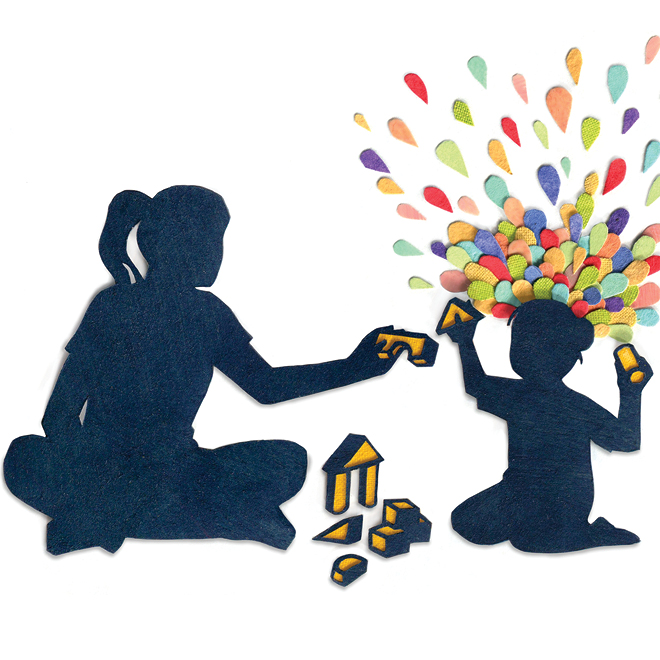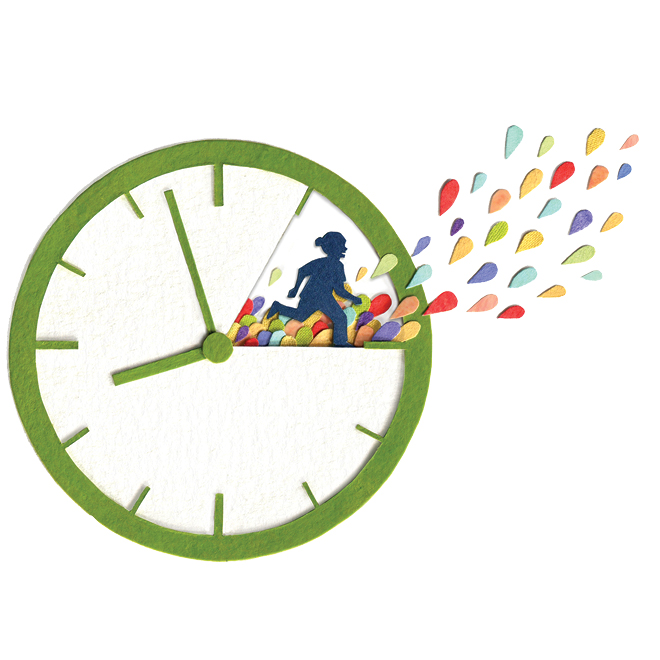Melissa Stenhouse knows how play can positively impact a kid. She’s seen it time and again in her role as program coordinator at Hamilton-based Today’s Family Early Learning and Child Care, a non-profit that offers child care and parental-support classes. But her favourite success story is about a girl named Zoey* and her love of pies.
Zoey was a grade four student in Stenhouse’s after-school program who had zero interest in reading. “We started to notice she was creating elaborate apparatuses out of blocks,” says Stenhouse, “and we figured out that she was building a set for a cooking show about pies.” So Stenhouse and her colleagues took it up a notch by adding baking—pies, specifically—to the program offerings. After they talked about what she would need to make a pie, Zoey learned to write out a recipe and began to show an interest in cookbooks; this led to an increase in her desire to read. “It was incredible,” says Stenhouse. “Expressing herself through play expanded her reading, and she won’t put her books down now.”
But improved literacy is just the tip of the jungle gym when it comes to the benefits of play. It’s no secret that play is integral to a child’s overall development—researchers have been reporting this fact for decades. A 20-year study published in November 2015 out of Pennsylvania State University and Duke University found a correlation between social competence (one of the benefits derived from play) in kindergartners and their success as adults. Play is used in innovative ways for kids with cognitive, emotional and physical challenges and in treatment for trauma and grief. The United Nations High Commissioner for Human Rights declared play a basic human right of every child at the United Nations Convention on the Rights of The Child in November 1989.
When you think of what kids need—healthy food, education, a stable home—play might not make the list (but it should). Play is a kid’s most important job, yet it’s increasingly being threatened—by things like increased emphasis on academics, the proliferation of character toys over creative ones, and the trend toward overscheduling. But what is play exactly, and what can it do for your kid?
Play takes many forms, but at its core, it’s an activity that engages and challenges the mind. It can be completely child-directed, or it can be more ordered, with a set of instructions. It can be a solitary activity or a rousing game of make-believe with other kids. It can be producing and filming a YouTube video. If it gets your child to push the limits of the world they know, it’s play. And when given appropriate opportunities for it, it will help your kid grow in ways you would never have attributed to a set of LEGO® blocks or a sandbox. Read on for some of the key developmental benefits play can offer.
Kids learn life skills
The Center on the Developing Child at Harvard University says children must be provided with chances for “scaffolding,” or activities that practise life skills. This includes engaging in creative play and having chances to direct their own actions with decreasing adult supervision and intervention. Unstructured play, especially, helps with the development of executive function—fostering self-regulation (such as a person’s ability to stay calm and focused in stressful situations) and emotional coping, as well as problem-solving and planning abilities.
“Executive function happens in the frontal cortex: Those are your most important skills for making your way through life,” says Melissa Healy, a child and family psychotherapist with Canoe Therapy in Burlington, Ont. “If we’re not able to offer experiences that help foster those skills, research has shown that children will fall behind developmentally.”
In her therapy practice, Healy uses child-directed play, a method that’s also popular in academic circles. Many educators specifically reference the Reggio Emilia Approach when integrating open-ended play into their curricula. The Reggio Emilia philosophy says that this type of child-directed exploration is essential for development. The school of thought was developed after the Second World War in the Reggio Emilia region of Italy. A teacher named Loris Malaguzzi worked with parents to build schools that provided kids with a new way of learning that would encourage democratic thinking. He believed children are endowed with “a hundred languages” of expression—or a multitude of ways to relate to the world around them—and that for an education philosophy to be successful, kids had to have a degree of control and be treated as apprentices rather than the subjects of instruction. The philosophy is centred on respecting kids as resourceful individuals who can help guide their own learning; on positive relationships between kids, parents and teachers; and on treating the kids’ surroundings as a “third teacher.”
Stenhouse’s program is based on this educational philosophy. She and her colleagues treat the kids like they’re capable and competent, and try to give them real experiences—like Zoey having the opportunity to bake a pie—whenever they can. “It really is amazing,” she says. “We’ve found that, for most kids, when they’re doing something they’re interested in, behaviour issues often disappear.”
Communication comes from play
Learning to communicate effectively—to express thoughts and feelings, to learn how to gracefully insert yourself into a social situation or conversation, to ask for what you need or want—is vital to a successful adult life. “If a child just jumps into a group and takes a toy, the other kids are going to immediately expel him from that group,” says Daniel Chorney, a child psychologist in Halifax. “Learning to approach people and ask, ‘Can I play with you?’ is a huge communication skill that has lifelong importance.” Communication also includes the ability to pick up on social cues and to read facial and body language. All of this begins on the playground.
Chorney says giving kids a taste of all types of social situations —playdates, structured activities, free play—is important, but parents can also do skills training at home. “If a kid is really struggling with a specific thing (like asking to be included), a parent and child can role-play and practise acting out the problem. Then they can approach the dilemma in the real world and regroup after.”
Kids learn to resolve conflict
A long-term study from the University of Maryland found that between 1981 and 2003, children’s free time has dropped from 57 hours a week to 48, with outdoor play declining a whopping 37 percent. This type of unstructured, unmonitored play not only instills independence in kids but also helps them develop other important abilities, including developing appropriate problem-solving behaviours rather than always looking to an adult to manage circumstances for them.
Healy gives an explanation of how play, especially child-directed play, can help a kid learn lifelong skills: “Say you’re at the park, and another child pushes your child. The automatic reaction of the parent is to jump in and tell that other child to stop pushing, but that’s not helpful. It just proves that, ‘When someone pushes me, Mom’s going to swoop in and save me.’ But the reality is, Mom isn’t always going to be there.” You want kids to be able to handle these conflicts on their own. Children who haven’t had the experience to problem-solve in play situations will automatically look to an authority figure to take care of things, but children who have been faced with this type of confrontation during playtime are able to deal with it better.
Kids also learn the power of social censure on the playground. “Most of the time, if there’s a kid who’s consistently mean to others, that child is going to get excluded,” says Chorney. “If someone is too pushy, another child is going to correct that behaviour naturally. An understanding of logical social consequences should develop when we’re kids.”
Play helps with bonding
Play is a proven means for parents and educators to connect with kids. Healy finds that play is essential to building rapport with her clients. “Often, sitting down to have a conversation with a child about how they feel just doesn’t work,” she says. In therapy, play helps build connection and trust. “If, through play, we can better understand a child’s thoughts and feelings, that’s successful therapy. It’s also successful parenting.”
Play can be an important part of the relationship between a parent and child, too. Chorney often advises parents with kids struggling with behavioural issues to set aside time daily to just play one-on-one with them. This is part of an evidence-based treatment called Parent Management Training (programs like The Incredible Years, or Parent-Child Interaction Therapy, fall under this approach). These therapies focus on strengthening parents’ bond with their child as a means of improving emotional and behavioural problems.
“I’ll often suggest taking at least 15 minutes a day, with no distractions, to play something together that’s co-operative, that doesn’t have rules attached to it, where you don’t have to ask a lot of questions or give a lot of commands or criticisms.” That means board games are out, but you could build with blocks, make crafts or even just colour together. This shared fun time strengthens the attachment between parent and child, which encourages kids to look for positive attention from parents rather than seeking the spotlight by misbehaving.
This shared time can be as important for parents as it is for kids. “I have parents who will say, ‘I love my kid, but sometimes I hate them,’” says Chorney. “I’ll often tell them to go home and try this method because they’re going to laugh; they’re going to connect; they’re going to feel like they’re five years old again. It will help to remind them why they became a parent in the first place. It’s the kid equivalent of date night.”
Play increases kids’ capacity for learning
A 2007 report in the medical journal Pediatrics focusing on the importance of play in promoting healthy child development says, “play is integral to the academic environment. It has been shown to help children adjust to the school setting and even enhance children’s learning readiness, learning behaviours and problem-solving skills.”
The academic system in Finland—which is touted as one of the best in the world, with consistently high international assessment results—is a case in point. Because the Finns believe play is a valuable educational medium for young kids, children don’t start formal school until age seven (before that, they’re in pre-primary education, which has a focus on play). The school day is also typically structured in 45-minute blocks, with 15 minutes of free time between each period. The idea is that these breaks help kids stay focused during classroom time. But play is a form of education out of the classroom, too.
Deborah McCoy, a lifelong early childhood educator and the assistant vice-president for education at The Strong National Museum of Play in Rochester, NY, believes in kids helping direct their own learning. The Strong, which is a history museum but also an institution with a mission to focus on development through play, also uses the Reggio Emilia philosophy when creating its programs.
“We feel that imaginative play, especially, is really critical to building representational abilities,” says McCoy, “which is just a fancy way of describing using one thing to represent another, which is the foundation of literacy. It’s really important for kids to think in stories and act out stories. To do this spontaneously through play is really the best way, because it’s innate in children. Our job is to set up environments to support that.”
Exhibits in the museum include opportunities for arts and crafts, science experiments, sensory play (one of the areas, called Build, Drive, Go, even has a giant gravel pit kids can muck about in), and dress-up and imaginative play.
The Strong also has a part-time preschool called Woodbury School, where kids engage in fun activities set in the museum’s exhibits and teachers hold storytelling workshops. The instructors use play as the first step in teaching kids how to create plot lines—they provide items like figurines as inspiration and the kids are encouraged to tell the stories they’ve come up with. Teachers then write them down, which opens up even more opportunities for learning.
“Kids can read their stories back; they can read stories to their friends,” says McCoy. “It literally translates into their ability to read and write.”
There are so many benefits to regularly integrating play into a child’s day. As Chorney says, “Play is practice for real life.” It doesn’t have to take long, and often it just means standing back and letting your kid take the wheel. Sounds like a piece of cake, right? Or maybe a piece of pie.
Take 45 minutes to try
Unstructured play
Collect all of your empty cereal and tissue boxes, as well as paper towel and toilet paper rolls, or try to get your hands on a large appliance box. Set out the boxes, paint, markers, scissors (if the kids are old enough), glue, tape and jars of buttons and beads, and let your kids have at it. If they’re having a hard time getting started, give them a broad theme, like space or jungle.
Group or team play
Sit kids in a circle, and tell them they’re going to create a brand new game using a couple of balls, a skipping rope and a hula hoop (or whatever other active toys you have lying around). Each person is allowed to make up one or two rules. Write down the rules as the kids brainstorm and then try the game out. Decide together what works and what doesn’t.
Art or drawing
Place each child in front of a large mirror with a handful of dry-erase markers. Challenge the kids to draw their self-portraits by tracing their facial shape, features and hair. Add another element by encouraging them to enhance their image with items that reflect what they want to be when they grow up. Chef’s hat? Check! Stethoscope? You got it.
Role-play and make-believe
Find an old laundry hamper and fill it with a variety of old clothing and accessories. Tell kids to act out the characters they might find in a waiting room (or a restaurant, an office, a house, a classroom, etc.). Stand back and take pictures or videos or write down what the kids chose to be or do to remind them about it if they get stuck for ideas the next time they’re playing.
* names have been changed
A version of this article appeared in our September 2016 issue, titled “The power of play,” pg. 73-76.
Read more:
2o fun indoor games
4 classic playground games to play with your kid
14 fun games to play with your kids while lying down


